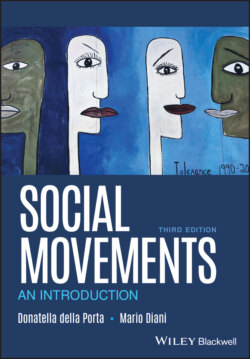Читать книгу Social Movements - Donatella della Porta - Страница 16
1.2.3 Social Movements, Events, and Coalitions
ОглавлениеWe have a social movement dynamic going on when single episodes of collective action are perceived as components of a longer‐lasting action, rather than discrete events; and when those who are engaged in them feel linked by ties of solidarity and of ideal communion with protagonists of other analogous mobilizations. Identity building also means that a sense of collective belonging can be maintained even after a specific initiative or a particular campaign has come to an end. The persistence of these feelings will have at least two important consequences. First, it will make the revival of mobilization in relation to the same goals easier, whenever favorable conditions recur. Movements often oscillate between brief phases of intense public activity and long latent periods (Melucci 1996) in which self‐reflection and cultural production prevail. The trust and solidarity links, activated in the European antinuclear movements during the mobilizations of the second half of the 1970s, for example, represented the base on which a new wave of protests gathered momentum in the wake of the Chernobyl incident in 1986 (Flam 1994a). Second, representations of the world and collective identities that developed in a certain period can also facilitate, through a gradual transformation, the development of new movements and new solidarities. For example, the close relationship existing in several countries between different waves of activism has been noted on a number of occasions (Dalton 2008; Grasso 2016; della Porta 2018b).
Reference to other examples of informal networks of collective action, such as coalitions, also illustrates why collective identity is such a crucial feature of social movements. In coalition dynamics, collective actors are densely connected to each other in terms of alliances, and identify explicit opponents, but those links are not necessarily backed by strong identity links. The networks between actors mobilizing on a common goal take a purely contingent and instrumental nature. Resource mobilization and campaigning is then conducted mainly through exchanges and pooling of resources between distinct groups and organizations. The latter rather than the network are the main source of participants’ identities and loyalties. Actors instrumentally share resources in order to achieve specific goals, yet do not develop any particular sense of belonging and of common future during the process. Once a specific battle has been fought, there need not be any longer term legacy in terms of identity and solidarity, nor attempts to connect the specific campaign in a broader framework (see e.g. Lemieux 1997, 1998). Of course, nothing prevents a coalitional dynamic from evolving into a social movement one, but it is still important to recognize the analytical difference between the two processes (Diani 2015).
It is worth stressing that associating movements to a distinctive collective identity implies no assumptions about the homogeneity of the actors sharing that identity. We have a social movement identity dynamic to the extent that groups and/or individuals feel part of a collectivity, mobilized to support or oppose social change; that they identify shared elements in their past, present, and future experiences; and that other social or political actors be held responsible for the state of affairs being challenged. Whether a specific collective identity will be inclusive or exclusive, and the degree to which holders of such identity will share one or several traits, is an empirical question (see chapter 4).
